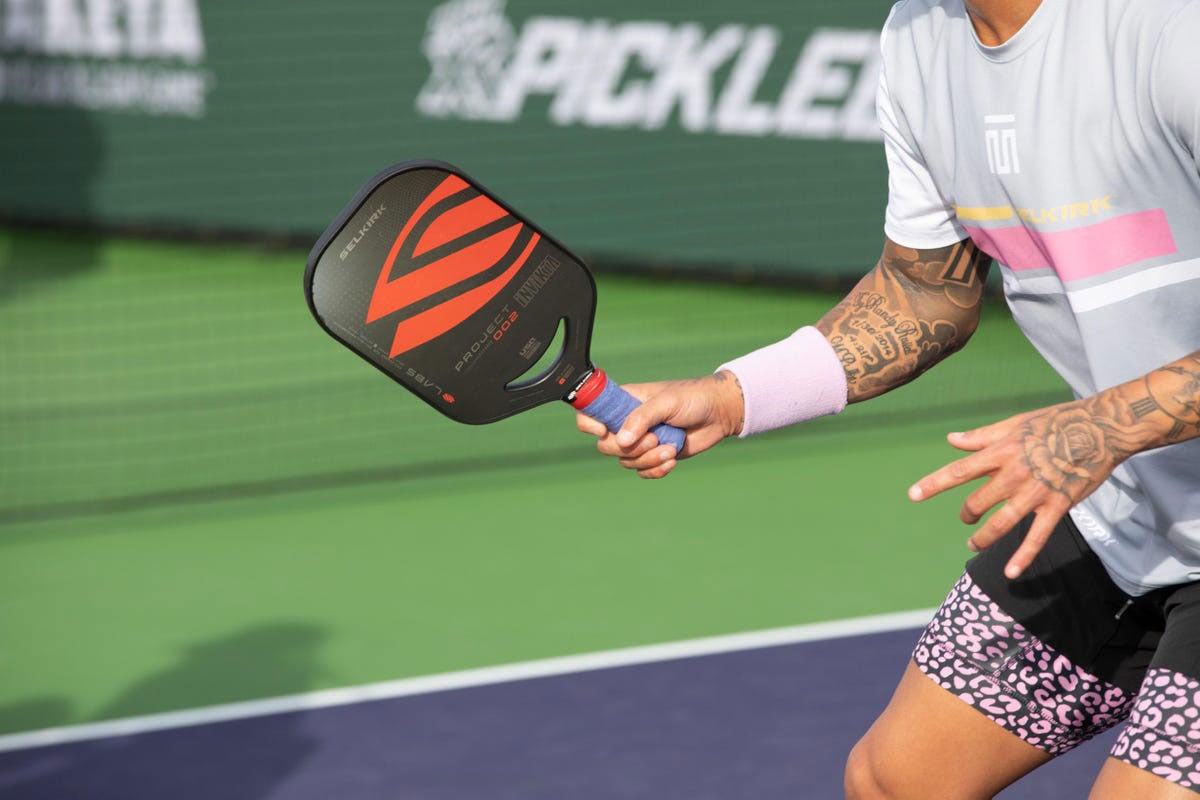
Pickleball is a racquet sport that originated in the USA but is now becoming more and more popular around the world. In fact, the Pickleball Australia Association says it’s the “fastest growing sport worldwide.” Introduced to Australia in 2015, the low-impact sport has been adopted by communities around the country.
But if you’ve never heard of it, what is Pickleball, how do you play it and where can you play it? Read on to find out.
In this Pickleball story…
What is Pickleball?
Pickleball is best described as a mash-up of a number of other racquet sports, including tennis, badminton and table tennis. The basis of the game sees two or four players (2 vs. 2) using solid paddles, similar to table tennis paddles, to hit a perforated ball over a net.
The court Pickleball is played is similar to a badminton court, and the net you have to hit the ball over is similar to a net from a tennis court.
History of Pickleball
Pickleball originated on Bainbridge Island, Washington in 1965 and was initially a game for children to play in their backyard. Joel Pritchard, a former politician who served in the U.S. House of Representatives as a Governor of Washington, is credited with inventing the game and its rules with a couple of his friends.
Pritchard and his friend, Bill Bell, wanted to play a backyard game of badminton one afternoon in 1965, but couldn’t find a shuttlecock. They then went to a badminton court and decided to try playing games using other racquets and balls. They eventually made their own, larger versions of table tennis paddles, lowered the badminton net and used a Cosom Fun Ball, and so Pickleball was created.
The name, Pickleball, is said to have come from a couple of potential sources. Joel’s wife, Joan Pritchard, said the name came about after she said to her husband the game reminded her of the Pickle Boat, which she said is where oarsmen “were chosen from the leftovers of other boats.” The connection here would be the use of various traits from other racquet sports.
It’s also been suggested the name was inspired by the Pritchards’ family dog, Pickles, although evidence suggests Pickles was named after the game.
Increase in popularity
Just a few years after inventing the game, Joel Pritchard and his friends found Pickleball had become incredibly popular with neighbours and relatives, and so in 1968, the group of friends formed Pickle Ball, Inc. They even began producing their own paddles and complete kits, so more and more people could play the game at home.
How To Play Pickleball
Despite Pickleball being created as a simple backyard game, there are official rules to follow and criteria for the court, net, paddle and ball.
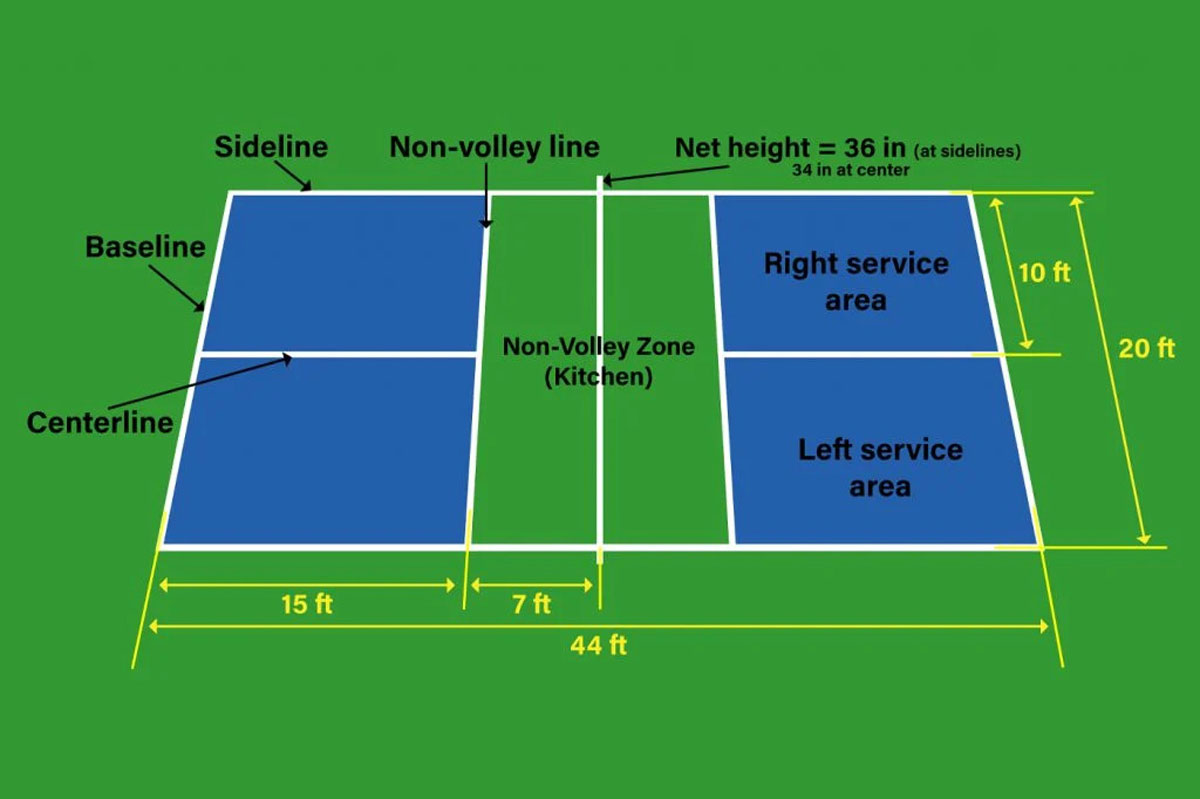
Court
Pickleball is played on a court that is 20 feet wide x 44 feet long, regardless if you’re playing singles or doubles. It’s the same size as a doubles badminton court. The front service line lies 7 feet from the net, making the service area 20 feet x 15 feet.
The area between the net and the front service line is known as the non-volley zone and the front service line is called the no-volley line. The back service line is known as the baseline.
Net
A Pickleball net is 36-inches high at the ends and 34-inches high at its centre. The net posts should be placed 22 feet apart, with the distance being measured from the inside edge.
Ball
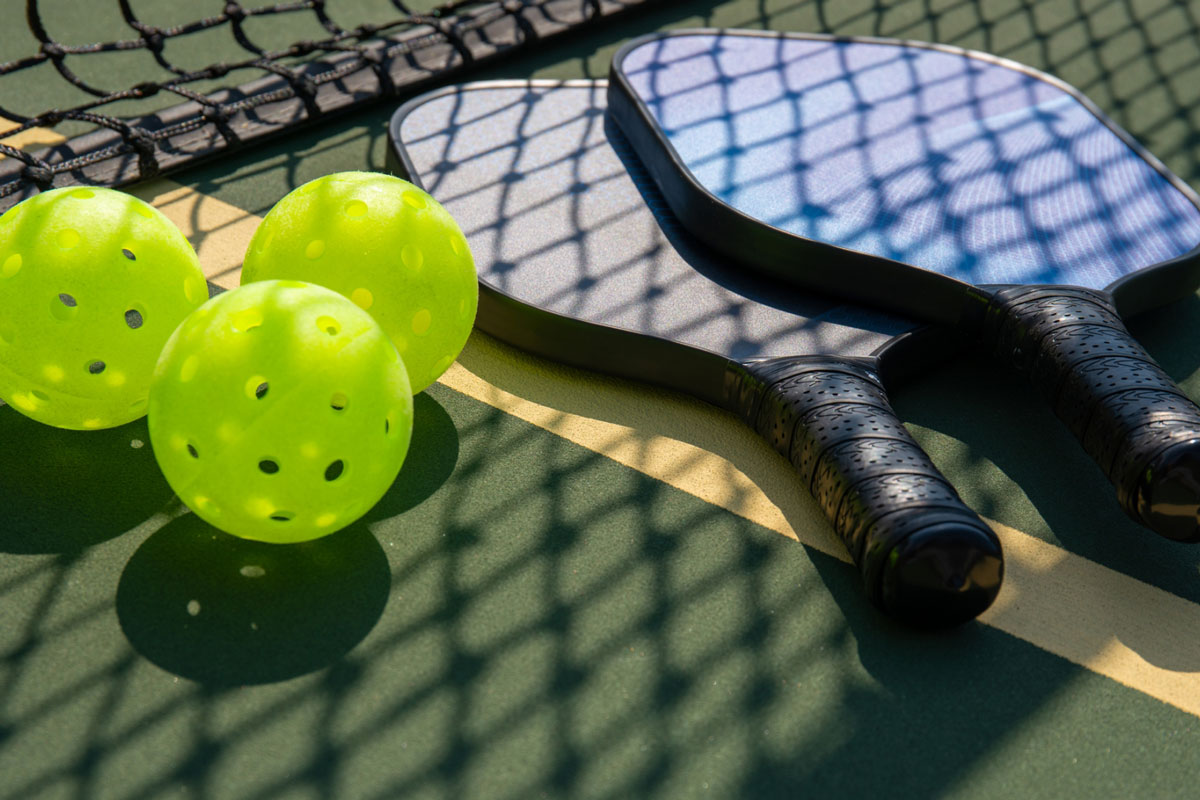
When Joel Pritchard first invented Pickleball, a wiffle ball was used – a perforated, lightweight ball – and a similar one continues to be used today. An official Pickleball ball now has to be made from a durable moulded material, with a smooth surface and 26 to 40 evenly spaced circular holes.
The Pickleball ball needs to weight between 22.1 and 26.5g and measure between 73 – 75mm in diameter. USA Pickleball and the International Federation of Pickleball have determined a list of pre-approved balls for use in official tournaments.
Paddle
Official Pickleball rules state there is no requirement with regards to the thickness or weight of a Pickleball paddle, but the combined length and width can’t exceed 24-inches, and the length can’t exceed 17-inches. Other criteria says the paddle’s surface must be smooth and be made from a non compressible material.
Rules
Players can determine who serves first in whichever way they wish, such as flipping a coin or even playing rock, paper, scissors, if you desire.
Singles
In a singles game of Pickleball, the server must take their first serve from the right service court. The ball is served to the diagonal crosscourt of their opponent, similar to other racquet sports. If an official oversees the match, they will announce the score before each serve. If you’re just playing casually, then the server has to announce the score before each serve.
The starting score is “zero zero” and goes up in single points.
Doubles
Doubles matches of Pickleball are a little more confusing to understand. The score has three parts; the serving team’s score, the receiving team’s score and the server number. The server number is either a 1 or 2, and refers to whether the current server is that team’s first or second.
In what could be seen as a slightly backwards way of determining server number, the first server of the game is considered to be their team’s second server and can take on the server number of “start” or “2”. The starting score in a doubles match would therefore be “zero zero start” or “zero zero 2.”
Manner Of Play
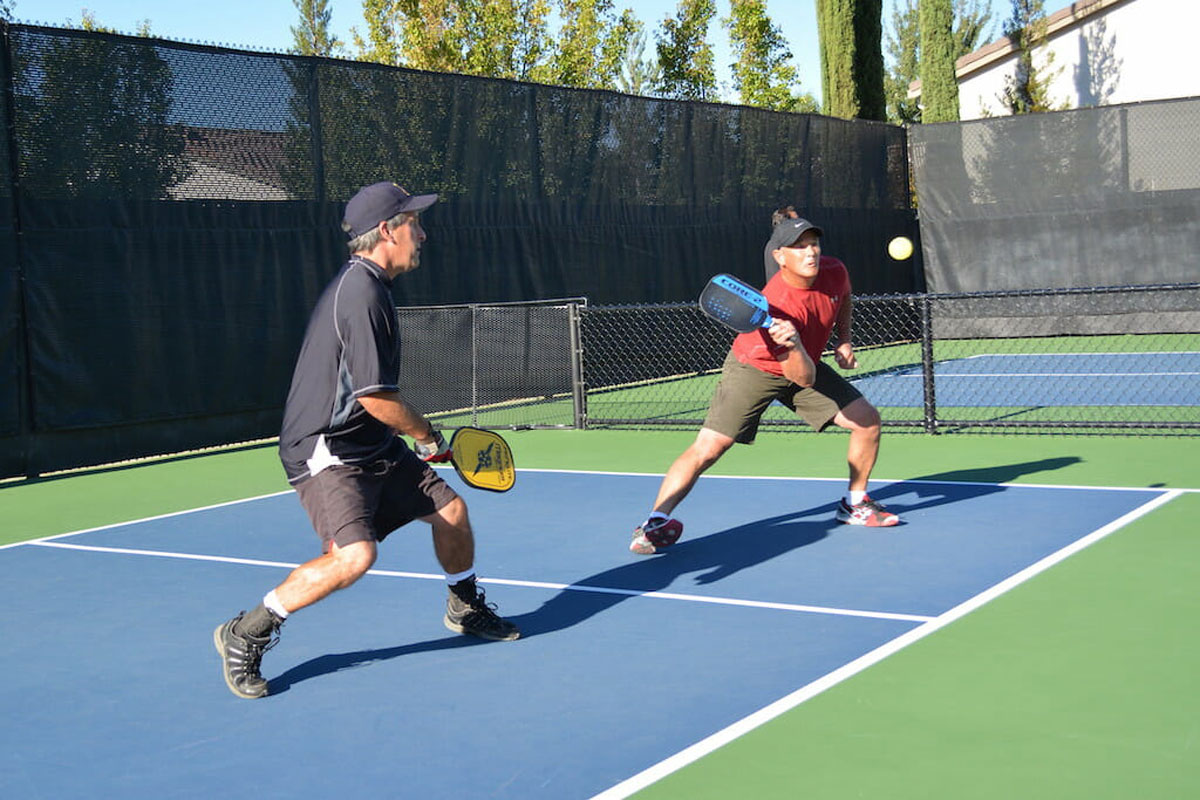
The first two plays in a Pickleball game require the ball to bounce once before being returned. I.e., once the server has served, the receiver must let it bounce once before hitting the ball back. Likewise, the server, now receiving the ball, must also let the ball bounce once before hitting it.
After this, players are allowed to volley the ball; i.e. hit it back without letting it bounce. The ball can never bounce twice before being returned, and players can’t volley the ball from the non-volley zone close to the net.
Serves must be taken from alternating right and left service courts. But, teams and players can be susceptible to faults.
Faults
Faults are called whenever any of the following occur:
- The wrong server hits the ball or serves from the wrong side of the court
- Either of the server’s feet step over or touch the baseline
- The ball isn’t hit into the opponent’s diagonal service court
- The wrong receiver returns the ball
- Volleying the ball when returning a serve
- Volleying the ball when returning the first service return
- Hitting the net
- Allowing the ball to bounce twice
- Hitting the ball out of the court
- Volleying the ball when inside the non-volley zone
- Touching the net
If either a singles player or a player on a team commits a fault, the serve switches to the opposing player.
In singles games, a player is called out – also known as a side-out – each time the serving player commits a fault. When a player does commit a fault, and the opponent then serves the ball, they must serve from the right side of the court – also known as the even side – if their current score is an even number. If their current score is an odd number, they must serve from the left side of the court.
In doubles games, each team is only allowed one fault before they are called out. Once both teams received a side-out, they are then allowed to commit two faults before being called out.
However, in doubles games, the serve must continue to be taken from alternate sides of the court. If one player on a team serves from the right side of the court and commits a fault, that team’s second sever must then serve from the left side of the court.
Serving
Two types of serve are permitted in Pickleball; a volley serve and a drop serve. Both must be performed behind the baseline and on one side of the court.
A volley serve is performed using an underhand motion and without letting the ball bounce on the ground before being hit. The ball has to be hit before the paddle reaches waist height, which is defined as being inline with the belly button.
A drop serve allows the ball to bounce on the ground before being hit by the serving player.
How To Win
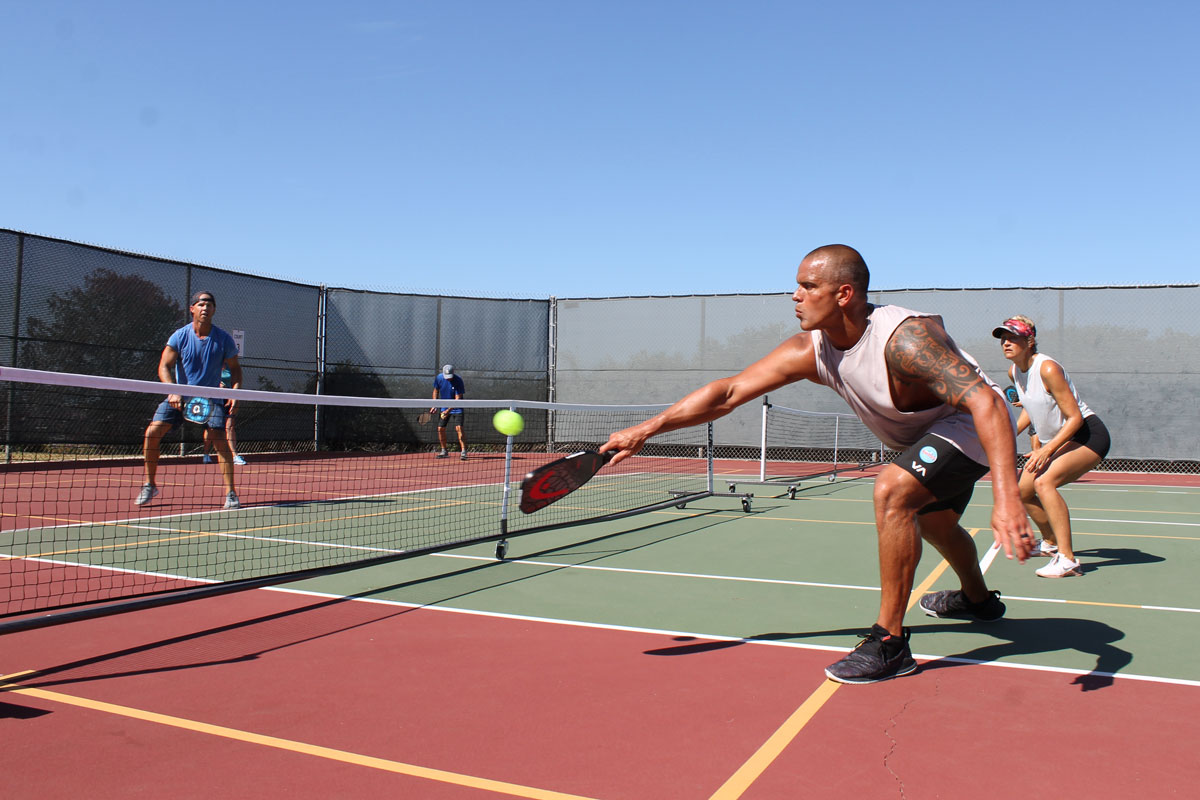
To win a game of Pickleball a player or team must get to 11 points and lead by at least two points.
Only the serving team can score points and can continue scoring points for each time the opposing side commits a fault. If the serving team commits a fault, nobody scores.
Where to Play Pickleball in Australia
Since being introduced to Australia in 2015, Pickleball has increased in popularity. This means you can now find courts to play Pickleball in every Australian state. We won’t list every single venue on this page, because there are far too many to mention. But, a full list of venues that host Pickleball games (days and times may vary) can be found on the official Pickleball Australia website.
Why is Pickleball Popular?
Pickleball has become popular because it mimics the style of play of other racquet sports, such as tennis and badminton, but is much easier to learn and to play.
Pickleball is far less intensive on the body compared to the likes of tennis and badminton, which require high speed serves. So, while you will still certainly get a workout from playing Pickleball, you’re unlikely to feel quite so exhausted once you’ve finished your game. It’s this reason that makes Pickleball popular with older people.
Pickleball is also an easier game to learn to play, or at least, doesn’t require quite as much skill as tennis, badminton or table tennis. The very fact that serves can be completed using an underhand swing means virtually anyone can learn how to serve a ball.The post What Is Pickleball? The Sport Taking The World By Storm appeared first on DMARGE.
0 Commentaires